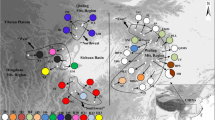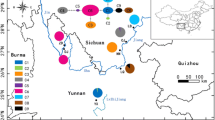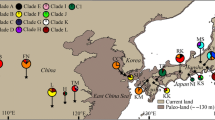Abstract
Ceratopteris thalictroides (L.) Brongn. (Parkeriaceae) is a difficult fern species to taxonomically classify. Three cryptic species were revealed in the previous studies, referred to as the north type, the south type, and the third type. Because much of the distribution range of C. thalictroides in China was not included in the sampling of the previous studies, the taxonomic complexity of C. thalictroides in China remained uncertain. In order to identify the uncharacterized cryptic species, we examined four chloroplast DNA (cpDNA) non-coding regions and compared sequence variation within this species complex. Sequence data were obtained from 143 individuals in 24 populations throughout the natural distribution of the species in China. Nineteen haplotypes were identified. Molecular systematic and phylogeographical analyses revealed two genetically distinct clusters of cpDNA haplotypes in China. One cluster included haplotypes associated with the north type, and another with the south type cryptic species. The N ST value was significantly higher than the G ST value (N ST = 0.768 > G ST = 0.434, P < 0.05), indicating the presence of a significant phylogeographical structure of C. thalictroides in China. The results of AMOVA analysis showed a significant inter-group differentiation (F ST = 0.918; P < 0.001). Analyses based on different, but complementary methods suggest that in China, C. thalictroides contains only two of the cryptic species (the north and south types). Two haplotypes, H8 and H17, of the interior node in the minimum-spanning network (MSN) of cpDNA haplotypes are widespread. The origin of the widespread haplotypes in China may have resulted from long-distance dispersal to China.



Similar content being viewed by others
References
Adjie B, Masuyama S, Ishikawa H, Watano Y (2007) Independent origins of tetraploid cryptic species in the fern Ceratopteris thalictroides. J Plant Res 120:129–138
Avise JC (2004) Molecular markers, natural history and evolution. Sinauer Associates, Sunderland
Bickford D, Lohman DJ, Sodhi NS, Ng PK, Winker K, Ingram KK, Das I (2006) Cryptic species as a window on diversity and conservation. Trends Ecol Evol 22:148–154
Clement M, Posada D, Crandall K (2000) TCS: a computer program to estimate gene genealogies. Mol Ecol 9:1657–1660
Crandall KA, Templeton AR (1993) Empirical tests of some predictions from coalescent theory with applications to intraspecific phylogeny reconstructure. Genetics 134:959–969
Dong YH, Robert WG, Chen JM, Wang QF (2005) Effect of habitat modification on the distribution of the endangered aquatic fern Ceratopteris thalictroides (Parkeriaceace) in China. J Freshw Ecol 20:689–693
Dong YH, Chen JM, Robert WG, Wang QF (2008) An investigation of genetic variation in the endangered aquatic fern Ceratopteris thalictroides (Parkeriaceae) in China: implications from RAPD and ISSR data for a conservation strategy. Bot J Linn Soc 157:657–671
Doyle JJ, Doyle JL (1987) A rapid DNA isolation procedure for small quantities of fresh leaf tissue. Phytochemistry 19:11–15
Excoffier L, Laval G, Schneider S (2006) ARLEQUIN version 3.1: a software for population genetic data analysis. Computational and Molecular Population Genetics Laboratory, Institute of Zoology, University of Berne, Switzerland
Felsenstein J (1985) Confidence limits on phylogenies: an approach using the bootstrap. Evolution 39:783–791
Ferris C, King RA, Vainola R, Hewitt GM (1998) Chloroplast DNA recognizes three refugia sources of European oaks and suggests independent eastern and western immigrations to Finland. Heredity 80:584–593
Fouquet A, Vences M, Salducci MD, Meyer A, Marty C, Blanc M, Gilles A (2007) Revealing cryptic diversity using molecular phylogenetics and phylogeography in frogs of the Scinax rubber and Rhinella margaritifera species groups. Mol Phylogenet Evol 43:567–582
Futuyma DJ (1998) Evolutionary biology, 3rd edn. Sinauer, Sunderland
Hao RM, Huang ZY, Liu XJ, Wang ZL, Xu HQ, Yao ZG (2000) The natural distribution and characteristics of the rare and endangered plants in Jiangsu, China. Chinese Biodivers 8:153–162
Huang JC, Wang WK, Peng CI, Chiang TY (2005) Phylogeography and conservation genetics of Hygrophila pogonocalyx (Acanthaceae) based on atpB-rbcL noncoding spacer cpDNA. J Plant Res 118:1–11
Kimura M (1980) A simple method for estimating evolutionary rates of base substitutions through comparative studies of nucleotide sequences. J Mol Evol 16:111–120
Kumar S, Tamura K, Nei M (2004) MEGA3: integrated software for molecular evolutionary genetics analysis and sequence alignment. Brief Bioinform 5:150–163
Lloyd RM (1974) Systematics of the genus Ceratopteris Brongn. (Parkeriaceae). II. Taxonomy. Brittonia 26:139–160
Masuyama S, Watano Y (1994) Hybrid sterility between two isozymic types of the fern Ceratopteris thalictroides in Japan. J Plant Res 107:269–274
Masuyama S, Watano Y (2005) Cryptic species in the fern Ceratopteris thalictroides (L.) Brongn. (Parkeriaceae). II. Cytological characteristics of three cryptic species. Acta Phytotax Geobot 56:231–240
Masuyama S, Yatabe Y, Murakami N, Watano Y (2002) Cryptic species in the fern Ceratopteris thalictroides (L.) Brongn. (Parkeriaceae). I. Molecular analyses and crossing tests. J Plant Res 107:269–274
Nishizawa T, Watano Y (2000) Primer pairs suitable for PCR-SSCP analysis of chloroplast DNA in angiosperms. J Phytogeogr Taxon 48:63–66
Paris CA, Wagner FS, Wagner WH Jr (1989) Cryptic species, species delimitation and taxonomic practice in homosporous ferns. Am Fern J 79:46–55
Pons J, Petit RJ (2006) Measuring and testing genetic differentiation with ordered versus unordered alleles. Genetics 144:1237–1245
Pons J, Barraclough TG, Gomez-Zurita J, Cardoso A, Duran DP, Hazell S, Kamoun S, Sumlin WD, Vogler A (2006) Sequence-based species delimitation for the DNA taxonomy of undescribed insects. Syst Biol 55:595–609
Posada D (2003) Using Modeltest and PAUP* to select a model of nucleotide substitution. In: Baxevanis AD, Davison DB, Page RDM, Petsko GA, Stein LD, Stormo GD (eds) Current protocols in bioinformatics. Wiley, New York, pp 6.5.1–6.5.14
Seidel RA, Lang BK, Berg DJ (2009) Phylogeographic analysis reveals multiple cryptic species of amphipods (Crustacea: Amphipoda) in Chihuahuan Desert springs. Biol Conserv 142:2303–2313
Swofford DL (2000) PAUP*. Phylogenetic Analysis Using Parsimony (*and other methods). Version 4. Sinauer Associates, Sunderland
Taberlet P, Gielly L, Pautou G, Bouvet J (1991) Universal primers for amplification of three non-coding regions of chloroplast DNA. Plant Mol Biol 17:1105–1110
Thompson JD, Higgins DG, Gibson TJ (1994) CLUSTAL W: improving the sensitivity of progressive multiple sequence alignment through sequence weighting, position-specific gap penalties and weight matrix choice. Nucl Acids Res 22:4673–4680
Unmack PJ, Dowling TE (2010) Biogeography of the genus Craterocephalus (Teleostei: Atherinidae) in Australia. Mol Phylogenet Evol 55:968–984
Watano Y, Masuyama S (1994) Genetic differentiation in population of the polymorphic fern Ceratopteris thalictroides in Japan. J Plant Res 107:139–146
Wilke T, Pfenninger M (2002) Separating historic events from recurrent processes in cryptic species: phylogeography of mud snails (Hydrobia spp.). Mol Ecol 11:1439–1451
Yu YF (1999) A milestone of wild plant conservation in China. Plants 5:3–11
Acknowledgments
We thank Dr. Yuanhuo Dong and Xiuqun Liu for their kindly assistance in fieldworks, Xiaoli Yue, Zhiyuan Du and Shuying Zhao for their help in the laboratory. This study was supported by grants from One Hundred Person Project of the Chinese Academy of Sciences granted to WQF (KSCX2-YW-Z-0805) and from the National Natural Science Foundation of China (No. 30800061 and No. 30970195).
Author information
Authors and Affiliations
Corresponding authors
Additional information
Y.-Y. Liao and X.-Y. Yang contributed equally to this paper.
Rights and permissions
About this article
Cite this article
Liao, YY., Yang, XY., Motley, T.J. et al. Phylogeographic analysis reveals two cryptic species of the endangered fern Ceratopteris thalictroides (L.) Brongn. (Parkeriaceae) in China. Conserv Genet 12, 1357–1365 (2011). https://doi.org/10.1007/s10592-011-0236-7
Received:
Accepted:
Published:
Issue Date:
DOI: https://doi.org/10.1007/s10592-011-0236-7




